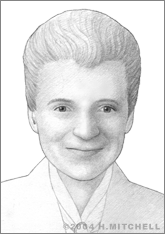Betsy Ancker
Betsy Ancker-Johnson began a uniquely diverse and illustrious career in physics, engineering, and public service just after World War II. Credited with a variety of inventions and achievements including the development of a type of high-frequency signal generator in the 1960s, she serves as one of the United States’ most distinguished role models for women as part of a generation that helped to change perspectives on gender roles and aptitudes in scientific fields.
Born on April 29, 1927, Ancker-Johnson was inspired by her mother, a homemaker, who encouraged her to wholeheartedly pursue whatever was most interesting to her. She chose physics, attending Wellesley College, where she earned a bachelor’s degree in 1949. Then she moved to Germany to attend the University of Tuebingen, where she completed her PhD in physics in 1953.
She married Hal Johnson in 1958 and the couple had four children. Meanwhile she maintained a very active and fruitful career that began first with a position at the University of California, Berkeley, where she was a lecturer from 1953 to 1954. She moved on to the Inter-Varsity Christian Fellowship in Chicago from 1954 to 1956. She then became a Senior Research Physicist with the Microwave Physics Laboratory at Sylvania Electric Products in Palo Alto, California from 1956 to 1958. During these years she developed a specialization in plasma and published a number of important research papers related to the field.
Ancker-Johnson has described plasma as a fourth state of matter after liquids, solids, and gases. Among her observations related to plasma studies were the occurrence of “pinching,” as well as the phenomenon of microwave emission from an electron-hole plasma — initiated only by the application of an external electric field. Her work in this area lead to subsequent findings that solid-state plasmas can serve as microwave sources of radiation.

During the 1960s, Ancker-Johnson worked for the David Sarnoff Research Center at RCA, as well as for the Plasma Physics Laboratory at the Boeing Science Research Laboratories in Seattle, and then as an Affiliate Professor of Electrical Engineering at the University of Washington from 1961 to 1973. Also during this time, she served as a visiting scientist at Bell Laboratories, as well as supervisor in the division of Solid State and Plasma Electronics at the Boeing Corporation.
It was while working with Boeing that she developed her most famous invention — a type of signal generator based on her finding that if a low-density plasma is established in a piece of semiconductor material in the presence of a high-intensity electric field and low-intensity parallel magnetic field, very high frequency signals — well into the gigicycle range — may be generated.
Ancker-Johnson found that if a plasma can be generated such that the density of plasma varies from one portion of the semi-conductor material to another, a relatively high intensity electric field may be applied without the occurrence of impact ionization. Normally, impact ionization phenomena prevent the formation of low density plasma required for this invention to work effectively. The necessary gradation in plasma density can be created in numerous ways, including using semiconductor materials with either a gradient in relative purities, surface finishes, cross sectional area, or by applying appropriate electromagnetic radiation.
Ancker-Johnson was issued U.S. Patent #3,287,659 for “Signal Generators Using Semiconductor Material in Magnetic and Electric Fields” on Nov. 22, 1966. She has at least six other patents in this area.


